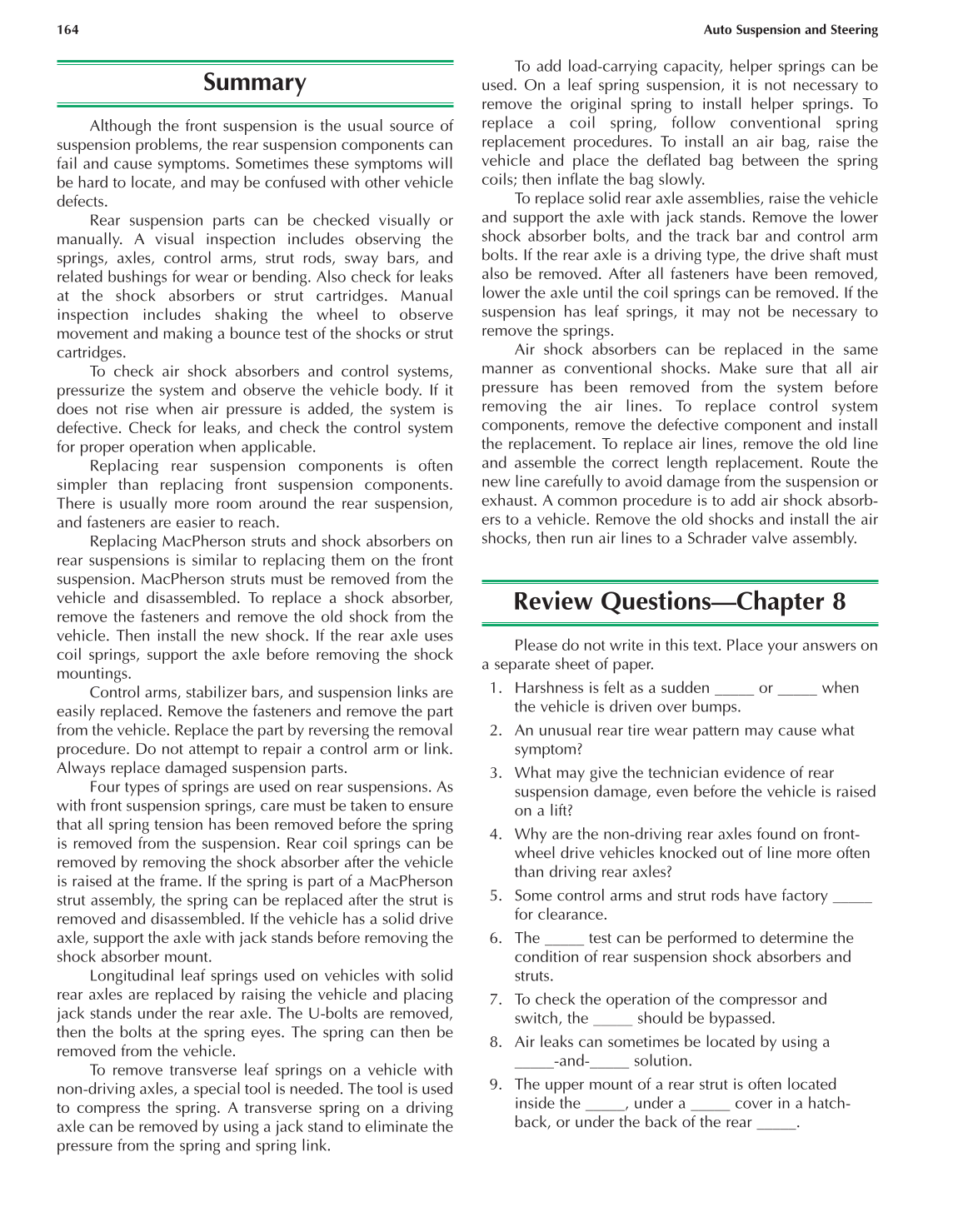164 Auto Suspension and Steering
Summary
Although the front suspension is the usual source of
suspension problems, the rear suspension components can
fail and cause symptoms. Sometimes these symptoms will
be hard to locate, and may be confused with other vehicle
defects.
Rear suspension parts can be checked visually or
manually. A visual inspection includes observing the
springs, axles, control arms, strut rods, sway bars, and
related bushings for wear or bending. Also check for leaks
at the shock absorbers or strut cartridges. Manual
inspection includes shaking the wheel to observe
movement and making a bounce test of the shocks or strut
cartridges.
To check air shock absorbers and control systems,
pressurize the system and observe the vehicle body. If it
does not rise when air pressure is added, the system is
defective. Check for leaks, and check the control system
for proper operation when applicable.
Replacing rear suspension components is often
simpler than replacing front suspension components.
There is usually more room around the rear suspension,
and fasteners are easier to reach.
Replacing MacPherson struts and shock absorbers on
rear suspensions is similar to replacing them on the front
suspension. MacPherson struts must be removed from the
vehicle and disassembled. To replace a shock absorber,
remove the fasteners and remove the old shock from the
vehicle. Then install the new shock. If the rear axle uses
coil springs, support the axle before removing the shock
mountings.
Control arms, stabilizer bars, and suspension links are
easily replaced. Remove the fasteners and remove the part
from the vehicle. Replace the part by reversing the removal
procedure. Do not attempt to repair a control arm or link.
Always replace damaged suspension parts.
Four types of springs are used on rear suspensions. As
with front suspension springs, care must be taken to ensure
that all spring tension has been removed before the spring
is removed from the suspension. Rear coil springs can be
removed by removing the shock absorber after the vehicle
is raised at the frame. If the spring is part of a MacPherson
strut assembly, the spring can be replaced after the strut is
removed and disassembled. If the vehicle has a solid drive
axle, support the axle with jack stands before removing the
shock absorber mount.
Longitudinal leaf springs used on vehicles with solid
rear axles are replaced by raising the vehicle and placing
jack stands under the rear axle. The U-bolts are removed,
then the bolts at the spring eyes. The spring can then be
removed from the vehicle.
To remove transverse leaf springs on a vehicle with
non-driving axles, a special tool is needed. The tool is used
to compress the spring. A transverse spring on a driving
axle can be removed by using a jack stand to eliminate the
pressure from the spring and spring link.
To add load-carrying capacity, helper springs can be
used. On a leaf spring suspension, it is not necessary to
remove the original spring to install helper springs. To
replace a coil spring, follow conventional spring
replacement procedures. To install an air bag, raise the
vehicle and place the deflated bag between the spring
coils; then inflate the bag slowly.
To replace solid rear axle assemblies, raise the vehicle
and support the axle with jack stands. Remove the lower
shock absorber bolts, and the track bar and control arm
bolts. If the rear axle is a driving type, the drive shaft must
also be removed. After all fasteners have been removed,
lower the axle until the coil springs can be removed. If the
suspension has leaf springs, it may not be necessary to
remove the springs.
Air shock absorbers can be replaced in the same
manner as conventional shocks. Make sure that all air
pressure has been removed from the system before
removing the air lines. To replace control system
components, remove the defective component and install
the replacement. To replace air lines, remove the old line
and assemble the correct length replacement. Route the
new line carefully to avoid damage from the suspension or
exhaust. A common procedure is to add air shock absorb-
ers to a vehicle. Remove the old shocks and install the air
shocks, then run air lines to a Schrader valve assembly.
Review Questions—Chapter 8
Please do not write in this text. Place your answers on
a separate sheet of paper.
1. Harshness is felt as a sudden _____ or _____ when
the vehicle is driven over bumps.
2. An unusual rear tire wear pattern may cause what
symptom?
3. What may give the technician evidence of rear
suspension damage, even before the vehicle is raised
on a lift?
4. Why are the non-driving rear axles found on front-
wheel drive vehicles knocked out of line more often
than driving rear axles?
5. Some control arms and strut rods have factory _____
for clearance.
6. The _____ test can be performed to determine the
condition of rear suspension shock absorbers and
struts.
7. To check the operation of the compressor and
switch, the _____ should be bypassed.
8. Air leaks can sometimes be located by using a
_____-and-_____ solution.
9. The upper mount of a rear strut is often located
inside the _____, under a _____ cover in a hatch-
back, or under the back of the rear _____.
